Abstract
BACKGROUND: Reference values and definitions of "normal" are prerequisites for population screening and classification of lung diseases. The aim of this study was to calculate reference values for never smoking Caucasian adults. METHODS: In the SAPALDIA cross sectional study respiratory health was assessed in a random sample of 9651 subjects, aged 18-60 years, from eight areas of Switzerland. Lung function was measured according to ATS criteria including quality control. In 3157 healthy never smoking adults without respiratory symptoms the mean values and fifth percentiles of lung function variables were calculated. For each sex, logarithms of lung function were regressed against age, age squared, and the logarithm of height. Residuals were used to estimate fifth percentiles across the age range using a technique not requiring normality or homoscedasticity of residuals. RESULTS: Most lung function variables were non-linear with age and showed an increase in early adulthood and an accelerated decline thereafter. The reference values for forced vital capacity (FVC) and forced expiratory volume in one second (FEV1) were higher than those of the European Community for Coal and Steel and those from North America. The prediction equations for lower fifth percentile values defined a stable proportion of subjects outside this limit whereas alternative methods for estimating the fifth percentile showed a loss of sensitivity with age. CONCLUSIONS: The reference equations for mean values of spirometric indices and their lower fifth percentiles gave an improved and unbiased lower limit of normal. The higher mean values may in part be due to the strictly selected population, quality control procedures, cohort effects, and altitude, and are not explained by the statistical model used.
Full text
PDF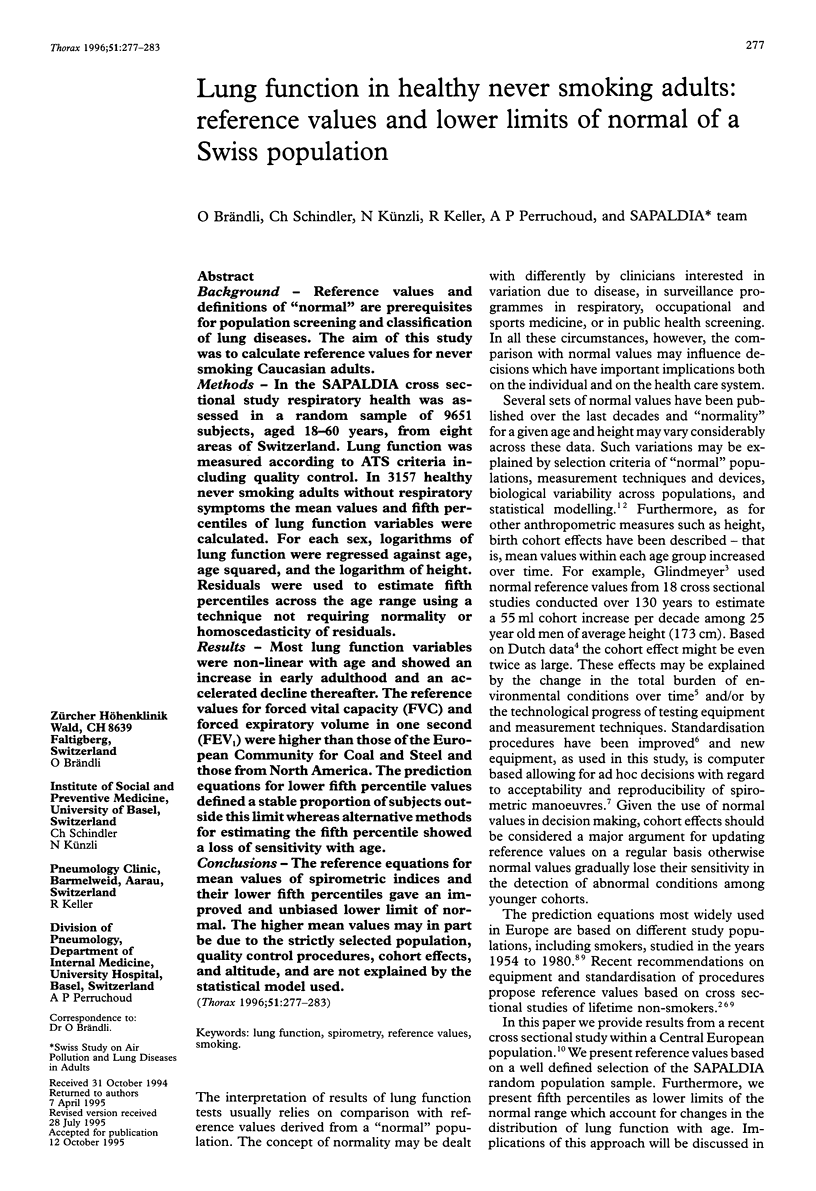
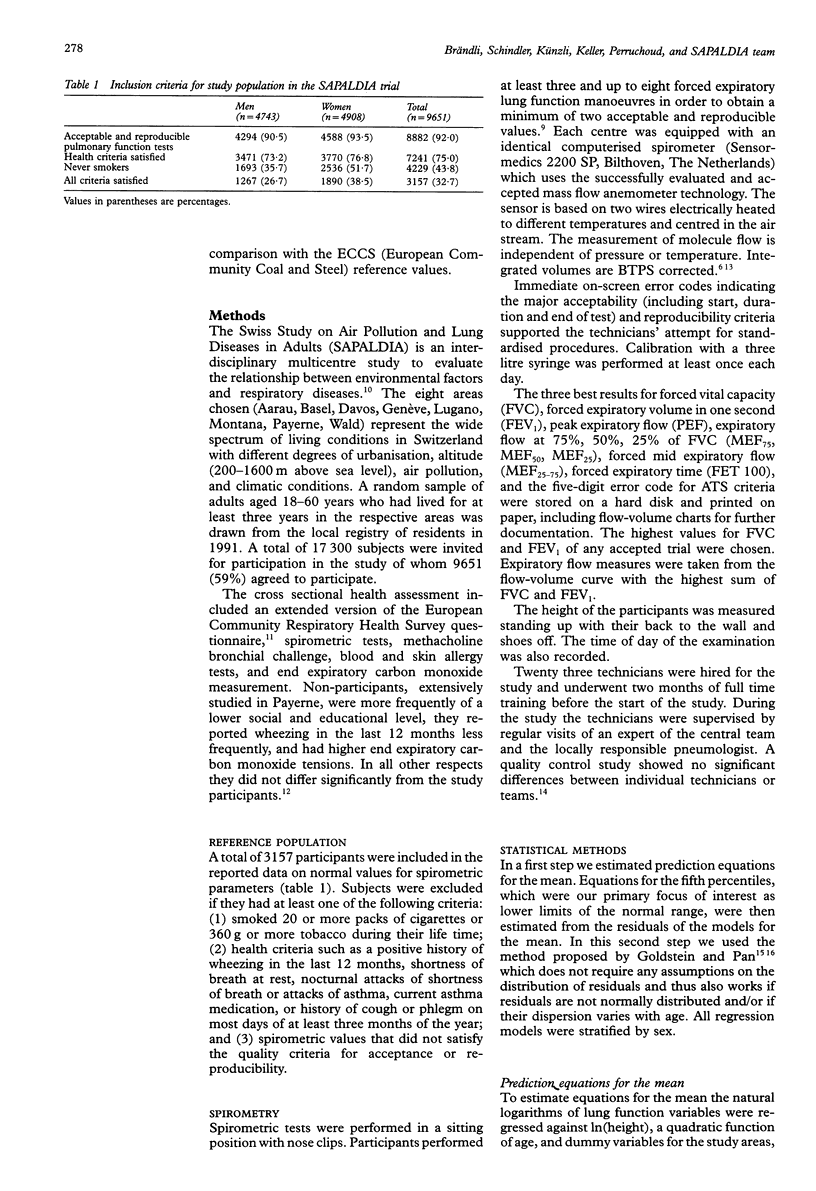
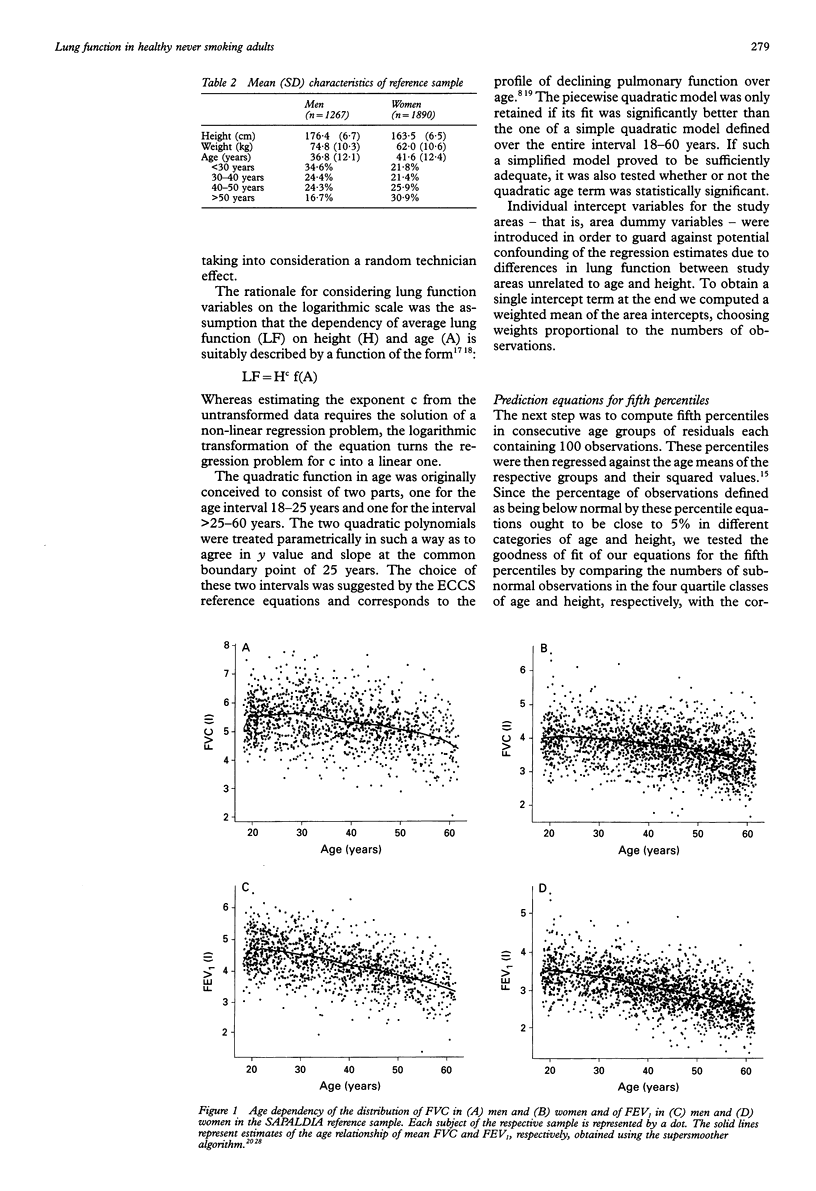
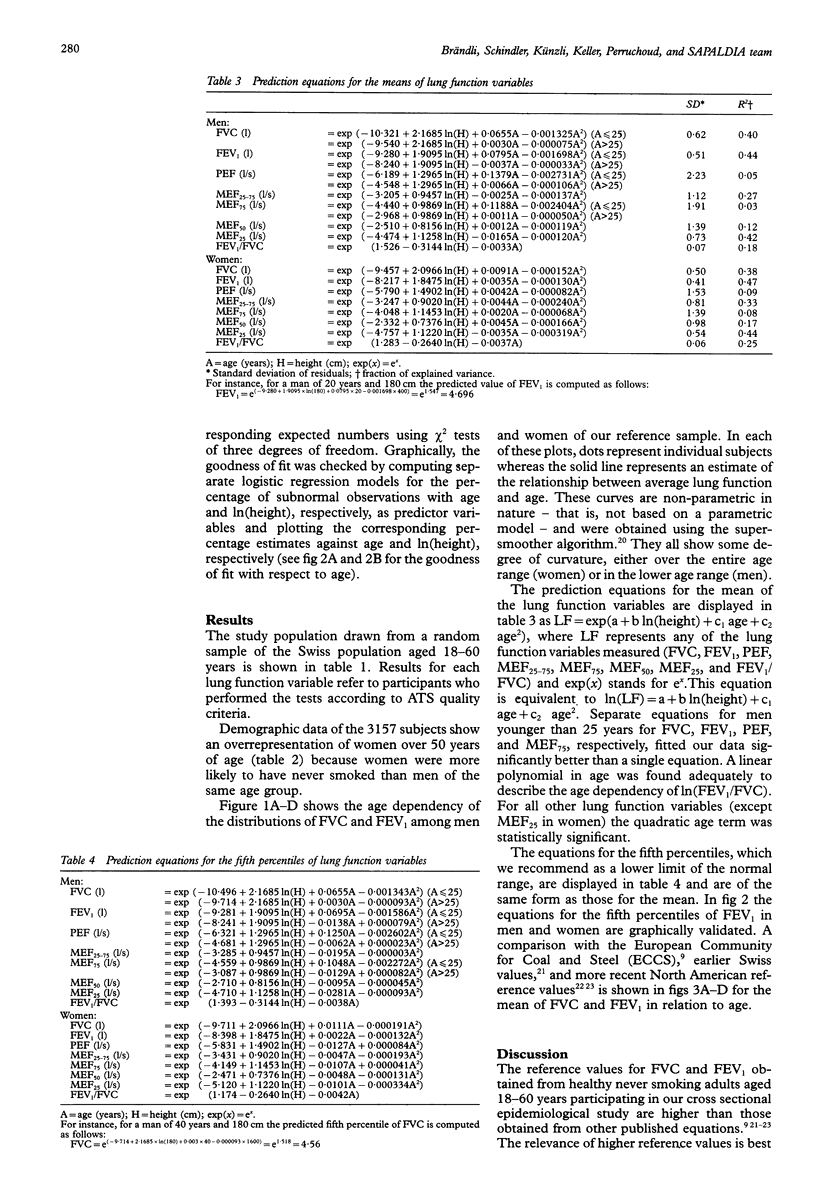

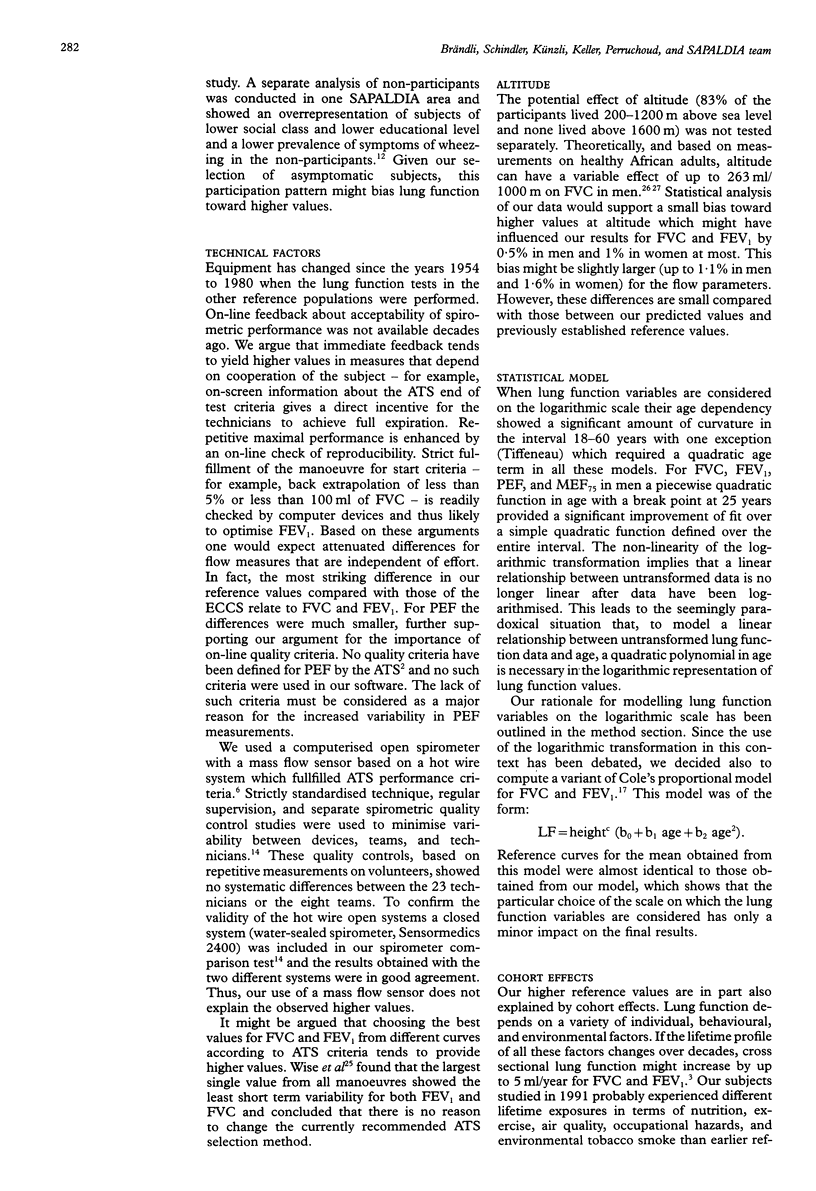
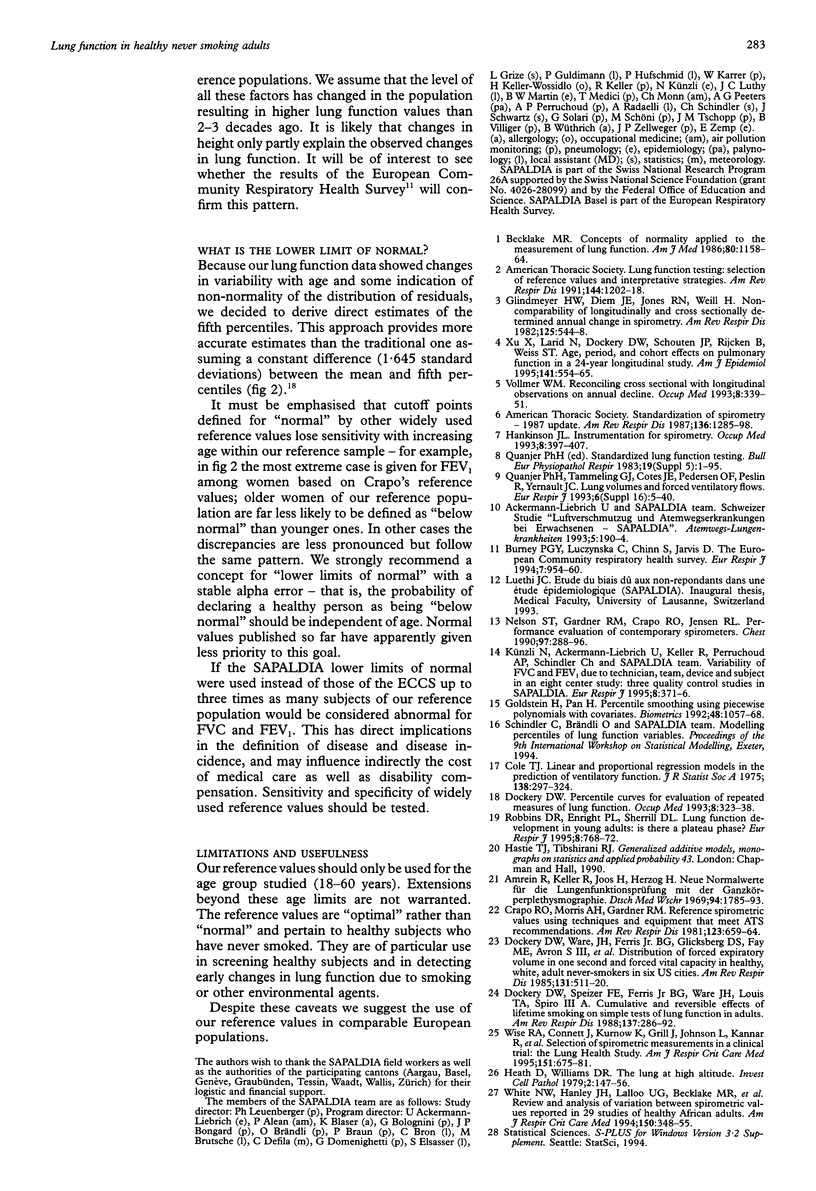
Selected References
These references are in PubMed. This may not be the complete list of references from this article.
- Amrein R., Keller R., Joos H., Herzog H. Neue Normalwerte für die Lungenfunktionsprüfung mit der Ganzkörperplethysmographie. Dtsch Med Wochenschr. 1969 Sep 5;94(36):1785–passim. doi: 10.1055/s-0028-1110341. [DOI] [PubMed] [Google Scholar]
- Becklake M. R. Concepts of normality applied to the measurement of lung function. Am J Med. 1986 Jun;80(6):1158–1164. doi: 10.1016/0002-9343(86)90678-9. [DOI] [PubMed] [Google Scholar]
- Burney P. G., Luczynska C., Chinn S., Jarvis D. The European Community Respiratory Health Survey. Eur Respir J. 1994 May;7(5):954–960. doi: 10.1183/09031936.94.07050954. [DOI] [PubMed] [Google Scholar]
- Crapo R. O., Morris A. H., Gardner R. M. Reference spirometric values using techniques and equipment that meet ATS recommendations. Am Rev Respir Dis. 1981 Jun;123(6):659–664. doi: 10.1164/arrd.1981.123.6.659. [DOI] [PubMed] [Google Scholar]
- Dockery D. W. Percentile curves for evaluation of repeated measures of lung function. Occup Med. 1993 Apr-Jun;8(2):323–338. [PubMed] [Google Scholar]
- Dockery D. W., Speizer F. E., Ferris B. G., Jr, Ware J. H., Louis T. A., Spiro A., 3rd Cumulative and reversible effects of lifetime smoking on simple tests of lung function in adults. Am Rev Respir Dis. 1988 Feb;137(2):286–292. doi: 10.1164/ajrccm/137.2.286. [DOI] [PubMed] [Google Scholar]
- Dockery D. W., Ware J. H., Ferris B. G., Jr, Glicksberg D. S., Fay M. E., Spiro A., 3rd, Speizer F. E. Distribution of forced expiratory volume in one second and forced vital capacity in healthy, white, adult never-smokers in six U.S. cities. Am Rev Respir Dis. 1985 Apr;131(4):511–520. doi: 10.1164/arrd.1985.131.4.511. [DOI] [PubMed] [Google Scholar]
- Glindmeyer H. W., Diem J. E., Jones R. N., Weill H. Noncomparability of longitudinally and cross-sectionally determined annual change in spirometry. Am Rev Respir Dis. 1982 May;125(5):544–548. doi: 10.1164/arrd.1982.125.5.544. [DOI] [PubMed] [Google Scholar]
- Hankinson J. L. Instrumentation for spirometry. Occup Med. 1993 Apr-Jun;8(2):397–407. [PubMed] [Google Scholar]
- Heath D., Williams D. R. The lung at high altitude. Invest Cell Pathol. 1979 Jul-Sep;2(3):147–156. [PubMed] [Google Scholar]
- Künzli N., Ackermann-Liebrich U., Keller R., Perruchoud A. P., Schindler C. Variability of FVC and FEV1 due to technician, team, device and subject in an eight centre study: three quality control studies in SAPALDIA. Swiss Study on Air Pollution and Lung Disease in Adults. Eur Respir J. 1995 Mar;8(3):371–376. doi: 10.1183/09031936.95.08030371. [DOI] [PubMed] [Google Scholar]
- Nelson S. B., Gardner R. M., Crapo R. O., Jensen R. L. Performance evaluation of contemporary spirometers. Chest. 1990 Feb;97(2):288–297. doi: 10.1378/chest.97.2.288. [DOI] [PubMed] [Google Scholar]
- Quanjer P. H., Tammeling G. J., Cotes J. E., Pedersen O. F., Peslin R., Yernault J. C. Lung volumes and forced ventilatory flows. Report Working Party Standardization of Lung Function Tests, European Community for Steel and Coal. Official Statement of the European Respiratory Society. Eur Respir J Suppl. 1993 Mar;16:5–40. [PubMed] [Google Scholar]
- Robbins D. R., Enright P. L., Sherrill D. L. Lung function development in young adults: is there a plateau phase? Eur Respir J. 1995 May;8(5):768–772. [PubMed] [Google Scholar]
- Vollmer W. M. Reconciling cross-sectional with longitudinal observations on annual decline. Occup Med. 1993 Apr-Jun;8(2):339–351. [PubMed] [Google Scholar]
- White N. W., Hanley J. H., Lalloo U. G., Becklake M. R. Review and analysis of variation between spirometric values reported in 29 studies of healthy African adults. Am J Respir Crit Care Med. 1994 Aug;150(2):348–355. doi: 10.1164/ajrccm.150.2.8049814. [DOI] [PubMed] [Google Scholar]
- Wise R. A., Connett J., Kurnow K., Grill J., Johnson L., Kanner R., Enright P. Selection of spirometric measurements in a clinical trial, the Lung Health Study. Am J Respir Crit Care Med. 1995 Mar;151(3 Pt 1):675–681. doi: 10.1164/ajrccm.151.3.7881655. [DOI] [PubMed] [Google Scholar]
- Xu X., Laird N., Dockery D. W., Schouten J. P., Rijcken B., Weiss S. T. Age, period, and cohort effects on pulmonary function in a 24-year longitudinal study. Am J Epidemiol. 1995 Mar 15;141(6):554–566. doi: 10.1093/oxfordjournals.aje.a117471. [DOI] [PubMed] [Google Scholar]


